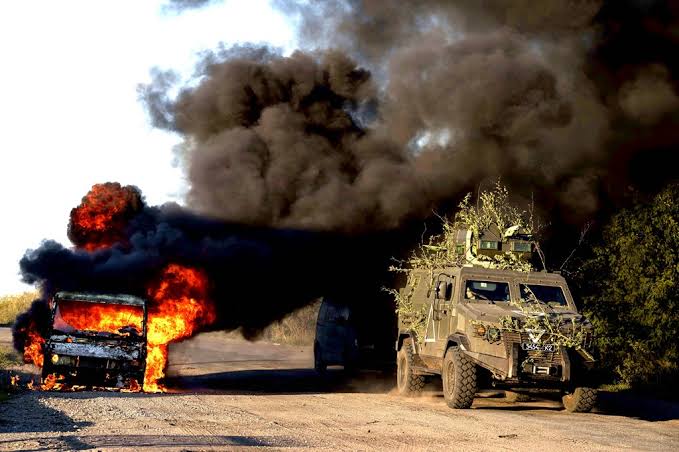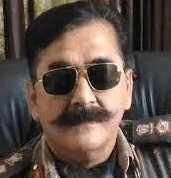Ukraine gamble on an incursion deep into Russian territory fails miserably

Ukraine’s stunning incursion into Russia’s Kursk border region was a bold gamble for the country’s military commanders, who committed their limited resources to a risky assault on a nuclear-armed enemy with no assurance of success. Naturally just like the bold gamble of Nazi Germany, this has flopped miserably with huge losses.
After the first signs of progress, Zelenskyy broke his silence and spelled out Kyiv’s daily advances to his war-weary public. By Wednesday, Ukrainian officials said they controlled 1,000 square kilometres of enemy territory, including at least 74 settlements and hundreds of Russian prisoners of war.
Now like Hitler, even Zelenskyy too is counting his daily loses and trying to prevent a rout of his retreating forces.
A week after it began, the overall aim of this senseless operation is still unclear: Will Ukraine dig in and be able to hold on to the occupied Russian territory, advance further into Russian territory or pull back to prevent total rout?
What is clear is that the incursion has changed the battlefield. The shock of Ukraine’s attack did surprise the Russians and some chinks in the armor were indeed seen. However at the Strategic level the attack risked aggravating Ukraine’s own weaknesses by extending the front line and committing new troops at a time when overall Zelenskyy is unable to motivate more Ukrainians to volunteer for his senseless War with Russia.
To conduct the Kursk operation, Kyiv deployed battalions drawn from multiple brigades, some of which were pulled from the hottest parts of the front line, where Russia’s advance has continued unabated. So far, Moscow’s overall strategic advantage is intact.
“The stretching of the front line for us is also stretching the front line for the enemy,” said the commander of the 14th Regiment of Unmanned Drones, who uses the call sign Charlie, after he participated in the opening stage of the offensive. “Only we have prepared for this operation in detail. The Russians were not prepared for this operation at all.”
As the offensive enters its second week, Ukrainian forces are now finding things very difficult with daily heavy unsustainable loses. They are now getting squeezd badly.Though on the lines of Nazi’s, a Goebbel like propaganda is on full blast. Ukraine claimed to have captured almost as much Russian land in Kursk as Russian forces took in Ukraine in the last seven months.
Ukrainian officials have said they do not intend to occupy Kursk, but they may seek to create a buffer zone to protect settlements in the bordering Sumy region from relentless Russian artillery attacks and to block supply lines to the northeast.
Russian authorities acknowledged the Ukrainian gains but described them as smaller. Even so, they have evacuated about 132,000 people.
Even Western analysts are now reserving judgment on whether the Kursk region is the right theater to launch an offensive. Estimates of the number of Ukrainian troops operating there range from 5,000 to 12,000.
Politically, the incursion has been planned to reset the terms with a message to Western allies that have dithered on supplying weapons and allowing donated weapons to be used for deeper strikes inside Russian territory.
Presidential adviser Mykhailo Podolyak suggested that the incursion may also strengthen Kyiv’s hand in future negotiations with Russia. Occupying part of Russian territory ahead of any cease-fire talks may give Ukraine some leverage.
Though the fighting continues, the territory currently under Ukrainian control is, by itself, of little economic or strategic value and reducing on daily basis.
“There is some important gas infrastructure in the area, but its usefulness is likely to be limited other than as a minor bargaining chip. Ukrainians have also cut a railway line running from Lgov to Belgorod,” said Pasi Paroinen of the Black Bird Group, a Finland-based open-source intelligence agency that monitors the war.
Major military bases are far from the current area of operations, and Ukrainian advances have not only stopped but are getting reversed as Russia sends in more forces.
Forcing Russia to deploy reserves intended for other parts of the 1,000-kilometer front line was the minimum aim, said Charlie, the commander. But so far, Moscow’s focus in the Donetsk region has not changed.
Instead Ukrainian troops were pulled from those very lines, where manpower shortages were a key factor that contributed to territorial losses this year.
In the strategically significant Pokrovsk area, which is the main thrust of Russia’s offensive effort, soldiers have seen few improvements since the Kursk incursion.
“Nothing has changed,” said a soldier known by the call sign Kyianyn. “If anything, I see the increase in Russian offensive actions.”
The Kursk operation does not seem to draw Russian attention away from the eastern front, where tens of thousands of Ukrainians have been killed and wounded, and where the Ukrainian military has struggled to repair cracks in its defences
.
Most territorial losses in June and July were recorded in the Pokrovsk area, which is near a logistics hub, with fighting intensifying near the towns of Toretsk and Chasiv Yar.
Russian forces dialed up those attacks to capitalize on troop fatigue and shortages. On many occasions, the losses were the result of poorly timed troop rotations and blunders that cast doubt about the overall strategy of the Ukrainian military’s General Staff.
“There is no way Russia will stop its actions in the parts of the front line where they are tactically succeeding,” Mashovets said. “There, they will push and squeeze until their last man is standing, no matter what.”




